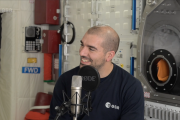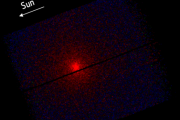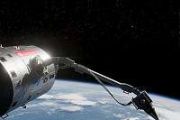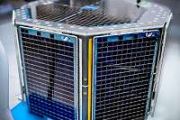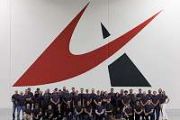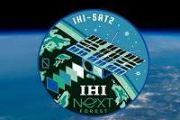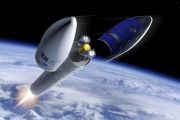
Copernical Team
High precision LLNL telescope to drive next generation lunar imaging
 Lawrence Livermore National Laboratory (LLNL) is advancing a major leap in lunar imaging through a partnership with Firefly Aerospace. The lab's cutting-edge optical telescope system is set to fly aboard Firefly's Elytra orbital platform as early as 2026, powering Firefly's commercial Ocula imaging service.
This will be the first commercial lunar imaging operation, offering unprecedented u
Lawrence Livermore National Laboratory (LLNL) is advancing a major leap in lunar imaging through a partnership with Firefly Aerospace. The lab's cutting-edge optical telescope system is set to fly aboard Firefly's Elytra orbital platform as early as 2026, powering Firefly's commercial Ocula imaging service.
This will be the first commercial lunar imaging operation, offering unprecedented u ULA, Amazon launch second batch of satellites on Atlas V rocket
 United Launch Alliance on Monday launched an Atlas V rocket carrying satellites for Amazon's Internet constellation.
The Atlas V rocket launched from the Florida Cape Canaveral Space Force Station on Monday, at 6:54 a.m. EDT, carrying 27 satellites to become part of its Project Kuiper constellation, which aims to provide Internet service to customers worldwide.
"We are proud to c
United Launch Alliance on Monday launched an Atlas V rocket carrying satellites for Amazon's Internet constellation.
The Atlas V rocket launched from the Florida Cape Canaveral Space Force Station on Monday, at 6:54 a.m. EDT, carrying 27 satellites to become part of its Project Kuiper constellation, which aims to provide Internet service to customers worldwide.
"We are proud to c Earth's satellites at risk if asteroid smashes into Moon: study
 If a huge asteroid smashes into the Moon in 2032, the gigantic explosion would send debris streaming towards Earth that would threaten satellites and create a spectacular meteor shower, according to researchers.
Earlier this year there were briefly fears that the 60-metre-wide (200-foot-wide) asteroid called 2024 YR4, which is big enough to level a city, would strike Earth on December 22, 20
If a huge asteroid smashes into the Moon in 2032, the gigantic explosion would send debris streaming towards Earth that would threaten satellites and create a spectacular meteor shower, according to researchers.
Earlier this year there were briefly fears that the 60-metre-wide (200-foot-wide) asteroid called 2024 YR4, which is big enough to level a city, would strike Earth on December 22, 20 Italy's IRIDE programme marks major step with first satellite constellation

Seven satellites have been launched for the Italian Earth observation mission, IRIDE. The satellites form part of the Hawk for Earth Observation (HEO) constellation, which carries multispectral optical instruments.
Living Planet Symposium 2025: Opening session
 Video:
02:08:03
Video:
02:08:03
ESA’s Living Planet Symposium, one of the world’s leading Earth observation conferences, opened today in Vienna. The plenary session began at 10:30 CEST and included addresses from ESA Director General Josef Aschbacher and ESA Director of Earth Observation Programmes Simonetta Cheli, as well as Margit Mischkulnig, from the Austrian Federal Ministry for Innovation.
There were video addresses from President of Austria, Alexander van der Bellen, Federal Minister for Innovation, Mobility and Infrastructure Republic of Austria Peter Hanke and the EU Commissioner for Defence and Space Andrius Kubilius. Representatives of the United Nations Office for Outer Space Affairs, ECMWF,
Living Planet Symposium Extras: Day 1

ESA’s week-long Living Planet Symposium kicked off today in Vienna, Austria, bringing together scientists and researchers from around the globe. Throughout the week, we’ll be covering the bigger stories in depth, such as the first images from ESA’s Biomass mission published earlier today – but we’re also sharing some daily snapshots of other significant happenings.
So, today’s few ‘extras’ include Sentinel-2 marking 10 years in orbit, ESA selects Telespazio to run the ground segment for the TRUTHS mission and listen to EarthCARE data transformed into a dragon’s song for peace.
SpaceX, NASA delay launch of crewed Axiom Space mission again
This request seems a bit unusual, so we need to confirm that you're human. Please press and hold the button until it turns completely green. Thank you for your cooperation!
Press and hold the button
If you believe this is an error, please contact our support team.
185.132.36.159 : fab33fa6-f4c2-46b3-821c-94284a5c
Reusable rocket prototype successfully launches and lands
This request seems a bit unusual, so we need to confirm that you're human. Please press and hold the button until it turns completely green. Thank you for your cooperation!
Press and hold the button
If you believe this is an error, please contact our support team.
185.132.36.159 : 82899e10-2a02-49ae-ba66-eeb6499e
Living Planet Symposium opens in Vienna

ESA’s Living Planet Symposium, one of the world’s leading Earth observation conferences, opened today in Vienna.
R&D Successes Onboard Biomass

For any space mission to launch, thousands of hours must have been spent iterating new technologies to make the spacecraft fly. The Biomass satellite, which today shared its first science data, is no exception. The probe, which carries just a single instrument on board, will perform a five-year census of all the trees on Earth to teach us more about how climate change and pests are affecting the world’s forests than we’ve ever learnt before.







